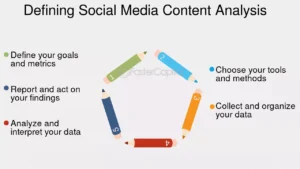How to use content analyzer for social media
In 2025, social media is a cornerstone of digital marketing, with platforms like X, Instagram, and TikTok driving brand engagement. However, creating content that resonates requires more than creativity—it demands data-driven insights. A content analyzer is a tool that evaluates social media content for performance, engagement, readability, and alignment with audience preferences. Many businesses struggle to leverage these tools effectively, missing opportunities to optimize their social media strategy.
This guide breaks down the problem of using a content analyzer for social media, identifies common challenges, outlines consequences of inaction, and provides a step-by-step solution with real-world examples. It also includes preventive tips and clear next steps to help clients maximize their social media impact.
Breaking Down the Problem: Using a Content Analyzer for Social Media
The problem of “how to use a content analyzer for social media” can be divided into smaller components:
-
Understanding Content Analyzers: Many clients are unfamiliar with what content analyzers do or which tools are best for social media.
-
Defining Goals: Businesses often lack clarity on what they want to achieve (e.g., higher engagement, better reach, or brand consistency).
-
Interpreting Data: Analyzing metrics like engagement rates, sentiment, or keyword performance can be overwhelming without guidance.
-
Applying Insights: Translating analyzer insights into actionable content changes is a common stumbling block.
-
Tool Integration: Integrating content analyzers with social media platforms or workflows is often complex.
Common Causes
-
Lack of Knowledge: Clients may not know which tools (e.g., Hootsuite Insights, Sprout Social, or Brandwatch) suit their needs.
-
Overreliance on Manual Analysis: Some rely on gut instinct or manual reviews, which are time-consuming and less accurate.
-
Misaligned Metrics: Focusing on vanity metrics (e.g., likes) instead of meaningful ones (e.g., shares, click-through rates).
-
Inconsistent Use: Using analyzers sporadically rather than as part of a routine workflow.
-
Technical Barriers: Difficulty setting up tools or connecting them to platforms like X or Instagram.
Consequences of Not Addressing the Issue

Failing to use a content analyzer effectively can lead to:
-
Poor Engagement: Content that doesn’t resonate reduces audience interaction, lowering brand visibility.
-
Wasted Resources: Time and budget spent on ineffective posts yield minimal ROI.
-
Competitive Disadvantage: Competitors using data-driven strategies will outperform those relying on guesswork.
-
Brand Misalignment: Inconsistent or off-target content can confuse or alienate audiences.
-
Missed Trends: Without analysis, businesses may overlook trending topics or hashtags, reducing relevance.
Step-by-Step Solution: How to Use a Content Analyzer for Social Media
Below is a comprehensive, actionable guide to resolve the issue, complete with tools, strategies, and real-world examples.
Step 1: Choose the Right Content Analyzer
Select a tool that aligns with your social media goals. Popular options in 2025 include.
-
Sprout Social: Offers engagement and sentiment analysis, ideal for tracking audience reactions.
-
Hootsuite Insights: Provides real-time analytics and competitor benchmarking.
-
Brandwatch: Specializes in social listening and trend identification.
-
Buffer Analyze: User-friendly for small businesses, with a focus on post performance.
-
Keyhole: Tracks hashtags and influencer campaigns, great for X and Instagram.
Action:
-
Identify your primary goal (e.g., engagement, reach, or sentiment analysis).
-
Compare tools based on pricing, ease of use, and platform integration (e.g., X, TikTok).
-
Start with a free trial to test features. For example, Sprout Social offers a 30-day trial.
Example: A small e-commerce brand chose Buffer Analyze for its simplicity and integration with Instagram. They used the free trial to test engagement metrics before committing.
Step 2: Define Clear Objectives
Clarify what you want to achieve with your social media content. Common goals include
-
Increasing engagement (likes, comments, shares).
-
Boosting click-through rates to a website.
-
Improving brand sentiment (positive audience reactions).
-
Identifying trending topics or hashtags.
Action:
-
Use the SMART framework (Specific, Measurable, Achievable, Relevant, Time-bound). Example: “Increase Instagram post engagement by 20% in 3 months.”
-
Align metrics with goals. For engagement, track comments and shares; for reach, monitor impressions.
Example: A fitness influencer set a goal to increase X post shares by 15% in 2 months using Keyhole to track hashtag performance.
Step 3: Set Up the Content Analyzer
Proper setup ensures accurate data collection.
Action:
-
Connect the analyzer to your social media accounts (e.g., link X or Instagram via API).
-
Configure dashboards to display key metrics (e.g., engagement rate, audience demographics).
-
Set up alerts for spikes in mentions or negative sentiment.
-
Use templates if available. For example, Hootsuite offers pre-built dashboards for engagement tracking.
Tip: Check platform-specific guides (e.g., Sprout Social’s X integration tutorial) to avoid setup errors.
Example: A café used Hootsuite Insights to connect their X account and set up a dashboard tracking mentions of their #CoffeeLovers campaign, enabling real-time monitoring.
Step 4: Analyze Content Performance
Run analyses to evaluate existing and new content.
Action:
-
Engagement Analysis: Review likes, comments, shares, and click-through rates. Identify top-performing post types (e.g., videos, polls).
-
Sentiment Analysis: Check if audience reactions are positive, negative, or neutral. Tools like Brandwatch excel here.
-
Keyword/Hashtag Tracking: Use Keyhole or Sprout Social to find trending hashtags or keywords relevant to your niche.
-
Competitor Benchmarking: Compare your performance to competitors using Hootsuite or Buffer.
Tip: Schedule weekly analysis sessions to spot trends early.
Case Study: A fashion retailer used Sprout Social to analyze their Instagram Reels. They found video posts with #OOTD (Outfit of the Day) had 30% higher engagement than static images, prompting a shift to video-first content.
Step 5: Apply Insights to Optimize Content
Use analyzer data to refine your social media strategy.
Action:
-
Adjust Posting Times: Post when your audience is most active (e.g., Buffer Analyze’s “Best Time to Post” feature).
-
Refine Content Types: Double down on high-performing formats (e.g., carousels, stories).
-
Incorporate Trends: Use trending hashtags or topics identified by the analyzer.
-
A/B Test: Create two versions of a post (e.g., different captions) and use the analyzer to compare performance.
Example: A tech startup noticed their X posts with question-based captions (e.g., “What’s your favorite app?”) had 25% higher engagement via Keyhole. They began using questions in 80% of posts.
Step 6: Monitor and Iterate
Continuous monitoring ensures long-term success.
Action:
-
Set up monthly reports to track progress toward goals.
-
Use analyzer alerts to catch sudden drops in engagement or negative sentiment.
-
Experiment with new strategies based on insights (e.g., try TikTok if Instagram underperforms).
Tip: Use tools like Google Data Studio to visualize analyzer data for stakeholder reports.
Case Study: A nonprofit used Brandwatch to monitor sentiment after a fundraising campaign on X. When negative comments spiked due to a misunderstood post, they quickly clarified with a follow-up post, restoring positive sentiment.
Tools and Resources
-
Content Analyzers: Sprout Social ($249+/mo), Hootsuite Insights ($99+/mo), Buffer Analyze ($50+/mo), Keyhole ($79+/mo), and Brandwatch (custom pricing).
-
Free Alternatives: Google Analytics for website-linked content, X Analytics for basic engagement metrics.
-
Learning Resources: Sprout Social’s blog, Hootsuite Academy, Buffer’s Social Media Toolkit (free e-book).
-
Integration Tools: Zapier to connect analyzers with CRM or email platforms.
Preventing Similar Issues in the Future
To avoid recurring challenges with content analyzers:
-
Train Your Team: Invest in tool-specific training (e.g., Hootsuite Academy courses).
-
Document Workflows: Create a guide for setting up and using your chosen analyzer.
-
Stay Updated: Follow industry blogs (e.g., Social Media Examiner) for trends in content analysis.
-
Automate Where Possible: Use scheduling tools like Buffer to streamline posting and analysis.
-
Regular Audits: Conduct quarterly reviews of your social media strategy to ensure alignment with goals.
Real-World Case Study: How a Bakery Boosted Engagement
Client: SweetTreats Bakery, a small business on Instagram and X. Problem: Low engagement (2% average) despite frequent posting. Solution:
-
Adopted Buffer Analyze to track engagement metrics.
-
Set a SMART goal: Increase Instagram engagement to 5% in 3 months.
-
Analyzed posts and found carousel posts with recipes performed best.
-
Shifted to posting 3 carousels/week with #BakingTips, identified as trending via Keyhole.
-
Adjusted posting times to 7 PM, when audience activity peaked. Results: Engagement rose to 6.2% in 10 weeks, with a 40% increase in followers. Lesson: Data-driven content adjustments, guided by a content analyzer, significantly improved performance.
Next Steps and Call to Action
To start using a content analyzer for your social media:
-
Today: Choose a tool (e.g., Buffer Analyze or Sprout Social) and sign up for a free trial.
-
This Week: Set up the tool, connect your accounts, and define 1–2 SMART goals.
-
Next 2 Weeks: Analyze your last 10 posts and identify one change (e.g., new hashtag, different post type).
-
Ongoing: Schedule weekly analysis sessions and monthly reports to track progress.
Take Action Now: Don’t let ineffective content hold your brand back. Sign up for a content analyzer trial today and unlock data-driven social media success. Visit SproutSocial.com or Buffer.com to get started, or explore free resources at SocialMediaExaminer.com.

Premium AC duct cleaning in Dubai to maintain a fresh and healthy indoor environment: ac cleaning dubai cost